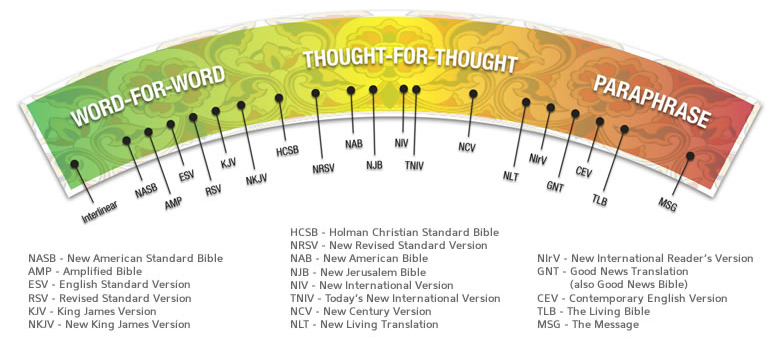
There are two main approaches to Bible translation, and all translatons fall somewhere along the spectrum between these two extremes. On one side is the functionally equivalent translation, sometimes called dynamically equivalency [Clarity of English Expression; 'thought for thought']. This is a translation that seeks to accurately convey the same meaning in a new language but is not so concerned about preserving the same number of words or equivalent grammatical constructions. The New Living Translation is a good example of a reliable functionally equivalent translation.
On the other end of the spectrum is the formally equivalent translation ['word-for-word'; correspondence to the form of the original language]. This type of translation is very concerned to preserve, as much as possible, the number of words and grammatical constructions from the original. Because languages are so different, a formally equivalent translation almost inevitably results in a stilted English style. The New American Standard Bible (NASB) and English Standard Version (ESV) are examples of formally equivalent translations. The New International Version (NIV) falls somewhere in the middle, being more functionally/dynamic equivalent [thought-for-thought] than the ESV but more formally equivalent [word-for-word] than the NLT.
For reading larger portions of Scripture (reading through the Bible in on year, for example), a person might choose a functionally/dynamic equivalent translation. For careful verse-by-verse study, one might prefer a more formally equivalent translation. In explaining a difficult passge to others in preaching or teaching, it is sometimes helpful to quote other Bible translations that clarify the meaning of the passage. Also, in personal study, reading a passage in multiple translations frequently results in increased comprehension. It is advisable to vary the Bible translation one reads to hear the text afresh.
A paraphrase is not really a Bible translation but an attempt to freely word the meaning of the biblical text. A paraphrase is usually done by one person and allows for more interpretive comments than a functionally equivalent translation. Sometimes a paraphrase seeks to recast the biblical narrative in the setting of a certain subculture.... The Message, by Eugene Peterson, seeks to clarify obscure passages and put them in the gritty language of everyday life.
The original Living Bible was a paraphrase of the American Standard Version (a formally equivalent translation completed in 1901) by Kenneth Taylor, which he composed for his children during his daily train commute. (The New Living Translation, however, is not a paraphrase but a dynamically equivalent translation). In contrast to paraphrases, Bible translations are always based on Greek and Hebrew texts and are worked on by large committees of diverse scholars, preventing a narrowness of interpretation and guaranteeing that the work remains a translation rather than veering into an idiosyncratic interpretation or paraphrase.
Information taken from the chapter titled
"Which is the Best English Bible Translation"
from 40 Questions for Interpreting the Bible,
by Robert Plummer

